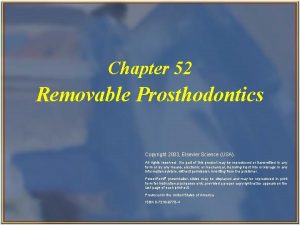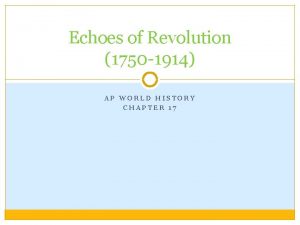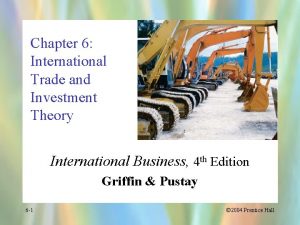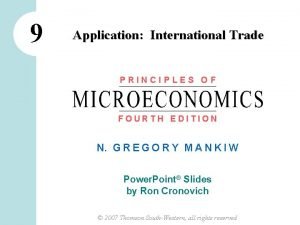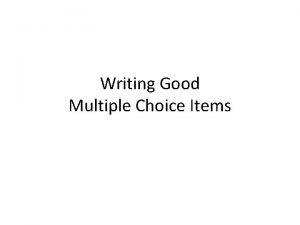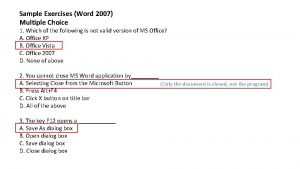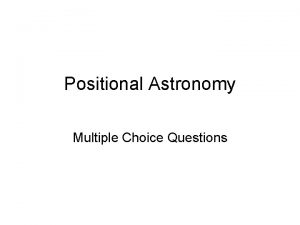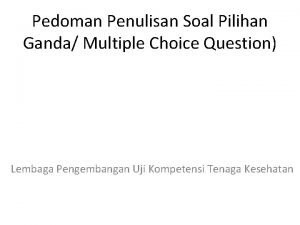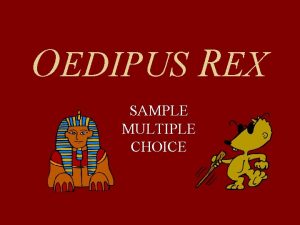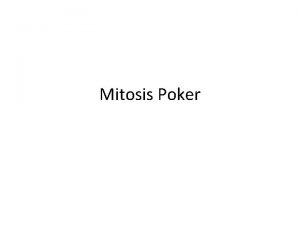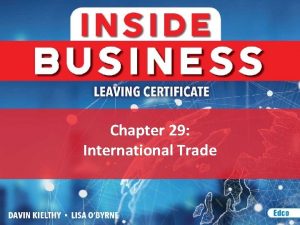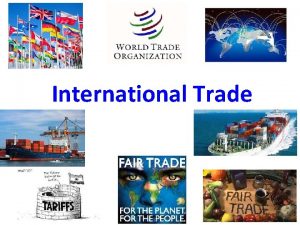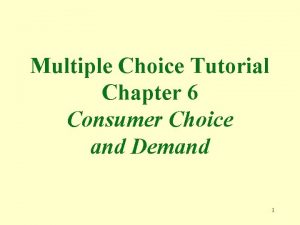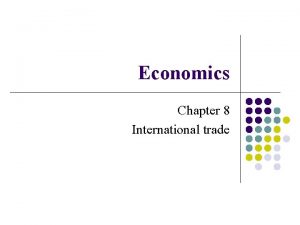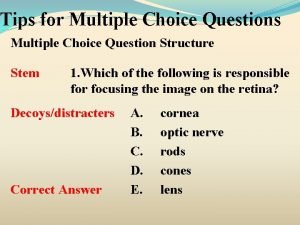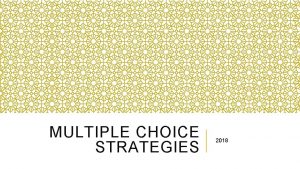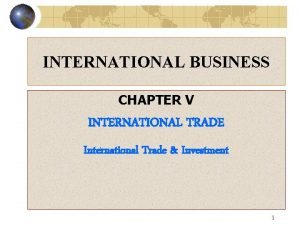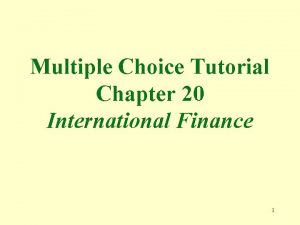Multiple Choice Tutorial Chapter 19 International Trade 1



































- Slides: 35

Multiple Choice Tutorial Chapter 19 International Trade 1

1. Exports account for what percentage of these countries’ gross domestic products? a. 50% in the United States and 12% in the Netherlands b. 33% in both the United and Germany c. 25% in the United States and 50% in Japan d. 12% in the United States and 13% in Japan D. The four main U. S. exports are: hightechnology products, industrial supplies, agricultural products, entertainment products. 2

2. The United States is a major exporter of a. diamonds b. bauxite c. coffee d. corn D. The two agricultural products exported the most are corn and soybeans. 3

3. Autarky means that a. a country’s consumption possibilities are the same as its production possibilities b. equilibrium has been reached with the maximum gains from specialization and trade c. equilibrium has been reached with the maximum amount of international trade d. the nation has such a high standard of living that there are technically no poor people A. Autarky is a situation of national selfsufficiency in which there is no economic interaction with foreigners. 4

4. The terms of trade are a. the length of time two individuals or countries have been trading b. the countries’ production possibilities curve c. the autarky equilibrium d. the exchange rates of two goods D. The value of different country’s currency differ from one another in terms of what each currency can buy. For example, an American dollar may buy a pound of coffee, but it might take ten Mexican pesos to buy the same pound of coffee, the exchange rate between the two currencies is 1 to 10. 5

5. A nation’s consumption possibilities frontier is a. always the same as its production possibilities frontier b. never the same as its production possibilities frontier c. the same as its production possibilities frontier only if there is advantageous trade d. the same as its production possibilities frontier only if there is no international trade D. If there is international trade a country’s consumption possibilities exceeds its production possibilities. 6

6. The gains from trade are due primarily to the fact that a. the wealth of large, industrialized nations can be spread throughout the world b. total world output increases when each country specializes c. countries can boost their economies by increasing exports B. By each county specializing each country becomes more efficient for several reasons; one reason is that non productive activity is eliminated. Total world output increases because of the resultant greater efficiency. 7

7. The source of gains from trade is a. tariffs b. self-sufficiency c. autarky equilibrium d. comparative advantage D. Comparative advantage is the ability of a country to produce something at a lower opportunity cost than other producers face. Even if Americans could make hand made wicker baskets better than any other country, we should not manufacture them because our opportunity costs would be so high, for example, time spent with the baskets would be time not spent on high technology 8 products.

8. Mutually beneficial trade cannot occur a. when each country has its own comparative advantage b. if one country has absolute advantages in the production of every good c. when the opportunity costs of producing each good are equal for both trading partners d. if total world production equals total world consumption C. Countries trade because they have different opportunity costs in producing goods and services. 9

9. To maximize worldwide gains from trade, the country which should produce a good is the country that a. has the lowest opportunity cost of producing that good b. can produce that good using the fewest resources c. will produce that good using the most expensive resources A. Since specialization makes possible an increase in productivity, the question becomes, what should a country specialize in? The answer is - in has the lowest opportunity cost. 10

10. Comparative advantage a. exists only when one producer can make the product using fewer resources than any other producer b. leads to the most efficient allocation of resources and the greatest combined output c. eliminates specialization, so that each country produces all of its own needs independently B. When a country produces a good that it has low opportunity cost, it is taking advantage of its comparative advantage. By producing goods with low opportunity costs it is giving up less in terms of foregone production than producing alternative goods. 11

11. Izodians can produce 8 units of food per day or 12 units of clothing per day. Valentians can produce 5 units of food per day or 10 units of clothing per day. Which of the following is true? a. mutually beneficial trade is not possible b. to maximize world production, Izodians should produce only food, Valentians should produce only clothing, and they should trade c. both countries should produce both goods and they should trade B. Izodians should produce food because its opportunity costs of clothing is higher than Valentia should produce clothing because its opportunity costs of food is higher than Izodia. 12

12. Which of the following is not an economic reason for international specialization? a. some countries have educated, trained workers, which other countries have unskilled workers b. tastes and preferences tend to be different in different countries c. the world price of a good is determined by the world supply and demand for the product C. Even though C is a truthful statement, it does not explain why a country should specialize in the production of a particular good or service. 13

13. When the world price of an internationally traded product is greater than a country’s domestic equilibrium price, a. the domestic price will prevail, and the world price is irrelevant b. the country’s import line is horizontal c. the country’s exports of the product will increase C. Goods are most often bought based on relative price differences between alternatives. If a country’s price of a good is less expensive that the alternative goods offered in the world market, demand will increase along with exports of that good. 14

14. The world price is in equilibrium when a. half of the individual countries’ domestic prices are higher and half of the individual countries’ domestic prices are lower b. the desired level of total world exports of the good equal the desired level of total world imports of the good c. each countries’ exports of this good equal its import of this good B. The key word is desired. When desired exports are greater than desired imports, prices will decrease to encourage more exports; when desired imports are greater than desired exports, prices of exports will 15 increase.

15. Producer surplus is the a. excess supply which exists when price is maintained above the world price b. difference between the marginal benefit of a product and the marginal cost producers incur in supplying the product c. difference between the actual revenue a producer receives and the minimum sum they would accept for a quantity of a good C. If you were willing to sell something for $100 but sold it for $150, the $50 difference is what is called producer surplus. 16

16. Consumer surplus result when a. the quantity demanded of a product equals the quantity supplied of that product. b. the quantity demand of a product is greater than the quantity supplied of that product. c. a consumer buys a good for less money then he was willing to pay. C. Consumer surplus results when a consumer buys something for a lower price than he was willing to pay. 17

17. With international trade a. producer surplus increases in both the exporting and importing countries b. consumer surplus increases in exporting countries and decreases in importing countries c. consumer surplus increases in the importing countries and producer surplus increases in the exporting countries C. Consumer surplus increases because the importing countries can buy goods at lower prices than they would pay otherwise. Producer surplus increases for the exporting countries because the greater demand allows them to sell the good for more than they could get for the good without international trade. 18

18. International trade a. benefits countries which export goods and hurts countries which import goods b. benefits poor, undeveloped countries and hurts wealthy, industrialized countries c. increases both producer surplus and consumer surplus throughout the world d. has a net beneficial effect only for countries with an autarky equilibrium C. Both consumer surplus and producer surplus increases because of the greater efficiency and the increase in the size of the market. 19

19. Trade restrictions in the real world a. are extremely rare, due to the economic benefits of specialization and trade b. hurt domestic producers and benefit foreign consumers c. hurt domestic producers and benefit domestic consumers d. hurt domestic consumers and benefit domestic producers D. Domestic consumers are hurt because they are forced to pay higher prices than they would pay otherwise. Domestic producers benefit because of less foreign competition. 20

20. A tariff is a. a tax on imports only b. a tax on exports only c. a on either imports or exports d. a luxury tax C. When a country places a tax on an import or export, the tax is called a tariff. A tariff would be placed on an import to discourage the importation of a particular good; a tariff would be placed on an export to discourage the exportation of a product. 21

21. The difference between a specific tariff and an ad valorem tariff is that a specific tariff a. is a set amount of money per unit of a product, while an ad valorem tariff is a set percentage of product price. b. is a set percentage of product price, while an ad valorem tariff is a set total amount c. names a particular good to which the tariff applies, while an ad valorem tariff applies to large classes of products. A. A tariff is a a tax on imports or exports. An example of a specific tariff would be $5 on a barrel of oil; an example of an ad valorem tariff would be a percentage of the price of 22 imports at the port of entry.

22. Which of the following is not an effect of a specific import tariff a. the domestic price is higher after the tariff is imposed b. there is no net welfare loss to society as a whole c. government collects revenue from the tariff d. the country’s imports of the product decline B. There is a net welfare loss because consumers are forced to pay higher prices than they would if it were not for the import tariff. 23

23. An import quota is a a. legal limit on the quantity of a good that can be imported per year b. legal requirement that a specified percentage of a final good’s value must be produced domestically c. legal requirements that exports to a specific country must exceed a specific value before the country’s product may be imported A. A second way to discourage the importation of a product is to limit the number of units that can be imported. With fewer units, the price will be higher than would be the case otherwise. This is called an import quota. 24

24. To be effective, an import quota must a. reduce the price and increase the quantity of imports b. set the price of the imported good higher than the domestic equilibrium price c. restrict imports to less than would be imported under free trade d. restrict imports to less than exports in trade with that particular country C. An import quota will not be effective unless it limits the amount of a product imported to less than otherwise would be the case. 25

25. An effective import quota a. increases consumer surplus and reduces produces surplus b. increases producer surplus and reduces consumer surplus c. increases both producer surplus and consumer surplus B. Producer surplus is the amount by which total revenue from production exceeds total variable costs. Consumer surplus is the difference between the maximum amount that a consumer is willing to pay for a given quantity of a good and what the consumer actually pays. The import quota will raise the price of the product above the price without the quota. 26

26. The primary difference between an import tariff and an import quota is that a. tariffs cause prices to rise, but quotas do not b. quotas cause prices to rise, but tariffs do not c. tariff revenues go to government, but quotas benefit those with the right to sell foreign goods domestically C. As a tax, tariffs bring in revenue for the government. A quota, on the other hand, benefits the sellers because they can now sell the imported product for more money. 27

27. Which of the following is not a type of trade restriction? a. low-interest loans to foreign buyers b. export subsidies for domestic firms c. domestic content requirements d. economies of scale D. Economies of scale exists when the large size of a producer enables it to gain greater efficiencies. This can result from trade restrictions, but is not a type of trade restriction. 28

28. The General Agreement on Tariffs and Trade (GATT) was established in a. 1870 to protect U. S. industries and decrease world trade b. 1921 to manage legal and accounting requirements for U. S. tariffs and quotas c. 1947 to reduce trade restrictions among 23 countries C. After WWII, which ended in June of 1945, countries could see the advantages of lower tariffs. However, they also recognized that this would not happen unless there was a great deal of cooperation, thus GATT. 29

29. The World Trade Organization (WTO) a. became, in 1995, the institutionalized and more comprehensive successor to the General Agreement on Tariffs and Trade (GATT) b. was established in 1947 to reduce trade restrictions among 23 member countries c. was established in 1980 to oppose and counteract the policies of the General Agreement on Tariffs and Trade (GATT) A. With a new round of agreements among participating nations, a name change was made. 30

30. The most-favored nation clause of the World Trade Organization requires that each member must a. offer to all member countries the same trade concessions offered to any member country b. choose one foreign member as its mostfavored trading nation, and give that country its most generous trade concessions c. offer some trade concession to any other member country offering it a trade concession A. This most-favored nation clause sealed the cooperation among all the members. 31

31. Regional trading bloc agreements a. are not considered trade restrictions b. are required by World Trade Organization rules c. exist primarily in Russia, Africa, and South America d. make special trade deals between countries in that region and discriminate against countries outside the region D. Regional trade blocs is an attempt of several countries to ban together and act as if they were one country as far as trade is concerned. 32

32. Which of the following is not used as an argument for trade restrictions? a. emerging domestic industries, especially those with economies of scale, could not gain entry in some world markets without protection during the early years b. trade restrictions are required to prevent some countries from exporting a commodity at a price below its cost of production c. consumer surplus is maximized only when strict import tariffs and quotas ensure that exports exceed imports C. Import tariffs and quotas lower consumer surplus because of the resultant higher price. 33

33. Rent seeking involves a. influencing public policy to redistribute income in one’s favor b. reducing costs and increase profit through greater efficiency c. raising price and increase profit by restricting output d. increasing market demand through advertising A. When a company, or an industry, sends lobbyists to Washington DC to influence politicians to vote for programs that will benefit them, this practice is an example of rent seeking. 34

END 35
 Chapter 56 oral and maxillofacial surgery multiple choice
Chapter 56 oral and maxillofacial surgery multiple choice Introduction to complete denture
Introduction to complete denture Elsevier
Elsevier Ch 46 impression materials
Ch 46 impression materials Sign chapter 37
Sign chapter 37 Ap world history chapter 17 multiple choice questions
Ap world history chapter 17 multiple choice questions Dental accessory instruments
Dental accessory instruments Chapter 59 dental sealants multiple choice
Chapter 59 dental sealants multiple choice Ap statistics chapter 7 test answer key
Ap statistics chapter 7 test answer key Chapter 5 elasticity and its application multiple choice
Chapter 5 elasticity and its application multiple choice Chapter 6 - theories of international trade and investment
Chapter 6 - theories of international trade and investment Chapter 9 application: international trade answers
Chapter 9 application: international trade answers Good choice or bad choice
Good choice or bad choice How to write multiple choice questions
How to write multiple choice questions Multiple binary choice items
Multiple binary choice items O be thou damned inexecrable dog
O be thou damned inexecrable dog The story of an hour multiple choice questions
The story of an hour multiple choice questions Stimulus based multiple choice questions
Stimulus based multiple choice questions Adverb quiz
Adverb quiz How to create multiple choice questions in word 2007
How to create multiple choice questions in word 2007 Recursion ap computer science
Recursion ap computer science Multiple choice questions for primary students
Multiple choice questions for primary students Ap lit practice mcq
Ap lit practice mcq Astronomy questions and answers multiple choice
Astronomy questions and answers multiple choice Persuasion mcqs with answers
Persuasion mcqs with answers Soal pilihan ganda (multiple choice)
Soal pilihan ganda (multiple choice) Graphic text osslt
Graphic text osslt Oedipus rex practice multiple choice questions answers
Oedipus rex practice multiple choice questions answers Direction for multiple choice test
Direction for multiple choice test Multiple choice questions on shakespeare sonnets
Multiple choice questions on shakespeare sonnets In figure 10-4 what role does structure a play in mitosis
In figure 10-4 what role does structure a play in mitosis Breast anatomy mcq
Breast anatomy mcq Vignette-style mcqs
Vignette-style mcqs Growth mindset multiple choice questions
Growth mindset multiple choice questions Combining sentences worksheet multiple choice
Combining sentences worksheet multiple choice When we take a census we attempt to collect data from
When we take a census we attempt to collect data from


